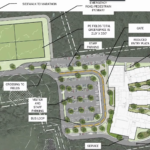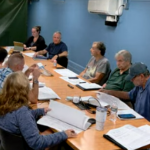
Fruit Street’s I-495 bridge is to be rebuilt this spring. FILE PHOTO/JERRY SPAR
Reconstruction of Fruit Street’s Interstate 495 bridge will begin in the late spring as an initial step to remodel the interchange between I-495 and I-90, representatives from the Massachusetts Department of Transportation announced at a two-hour virtual meeting Wednesday night.
Fruit Street’s other bridge — it sits about 1 mile northeast of the I-495 bridge, over railroad tracks on the border with Southborough and Westborough — currently is being redesigned by MassDOT. That section of the road has been closed to traffic for almost a year and is expected to remain closed for about another month.
About 90 people attended the meeting, where the 75 percent design plan was presented on the bridge reconstruction as well as Ramps ES and SE, which connect I-90 (MassPike) eastbound to I-495 southbound as well as I-495 southbound to I-90 eastbound. Work will begin in these areas as part of a nearly $300 million, five-year project to reconfigure the interchange, which straddles Hopkinton and Westborough, in an effort to improve traffic flow. The highway project is the first complete interstate-to-interstate interchange project the department has undertaken in its history.
Don Cooke from civil engineering firm VHB noted that this is a “design-build project,” where parts of the project will be constructed as others are being designed simultaneously.
“It’s key to understand that this is being constructed in an extremely sensitive environmental area,” he added, “which actually informs all of our design development as well as its construction.” He mentioned Whitehall Brook as well as the surrounding wetlands and floodplains.
During the Fruit Street I-495 bridge reconstruction, one lane will be maintained for two-way alternating traffic controlled with a temporary signal, Cooke explained.
There is a noise control plan “that is very robust,” he said, which was one of the biggest concerns residents raised later in the meeting. Baseline sound levels were established in December and will be reassessed on a quarterly basis throughout the length of the project. Temporary noise barriers will be in place during the construction, and the use of loud equipment will be limited to the daytime as much as possible.
The bridge work will be completed in two stages over the course of 22 months, explained civil engineer Chris Deacetis. It will include replacing the overpass, installing ADA-compliant sidewalks with ramps along the southern side of the roadway, and widening the roadway from 28 to 32 feet. The timeframe begins the first day the bridge is reduced to one lane.
The new 5-foot shoulders will be able to accommodate bicycles, he added. The sidewalks will be 5.5 feet wide, go over I-495 and connect to Huckleberry Road and Saddle Hill Road. Drainage improvements will be made to address the additional runoff created by the pavement.
The project has two main phases, with the first including the crosswalk at Huckleberry Road. The second section at the eastern segment of Fruit Street will include a proposed guardrail that will terminate at two residential driveways at 203 Fruit Street and 213 Saddle Hill Road. These driveways will be rebuilt at the new grade. The existing stone wall at 176 Fruit Street will be removed, and the one at 213 Saddle Hill Road will be rebuilt.
At Saddle Hill Road, the road “will begin to taper back to its existing condition, Deacetis said of the project’s third phase. This is where the new construction will end and where the ADA-compliant crosswalk and ramps will be installed.
“East of the bridge is where Fruit Street will be raised the most,” Deacetis noted. It will rise about 3.5 feet at the maximum elevation of the bridge. On the western end, it will be raised a maximum of 2 feet.
There will be no pedestrian or bicyclist access during the construction period — another point of concern expressed by residents during the meeting. Deacetis explained that there will not be sufficient space.
During the first phase of construction, traffic will flow on the northern half of the existing bridge with two-way alternating traffic while the southern half is built. Once this phase is completed, traffic will shift to the southern half. The old northern half will be demolished and the new bridge will be constructed. New utilities, a 6-inch sewer line, and access for a future water line will be constructed underneath the bridge.
Because Fruit Street is “a historical scenic roadway,” Deacetis said that the areas affected during construction will get new seeds and loam. There will be 171 new plantings, including 44 deciduous trees, 24 evergreen trees and 103 deciduous shrubs. Approximately 81 current trees along Fruit Street will be protected,” he added.
To accommodate the wider lanes and sidewalks, 78 trees of less than 12 inches in diameter will be removed as well as 24 trees with a caliper measurement greater than 12 inches.
After the presentation, questions lingered among residents regarding the trees, noise and accessibility for bikers and walkers.
Brad Fenn, who lives at the corner of Saddle Hill Road and Fruit Street, asked about the tree markings already in place. He asked which color ribbons designate which trees will be saved versus those being removed. Cooke noted that the blue ribbons indicate wetlands delineation, but the team was to confirm which trees will be removed.
Philip Fischer asked about consideration for bicycle and pedestrian traffic, noting that the area already has been impacted for a year by the closing of Fruit Street’s railroad bridge.
“This has been a route that has been used by runners, walkers and cyclists and has been cut off for 12 months,” he stressed.
Cooke explained that the roadway would not be wide enough to be safe for bikers and pedestrians during the bridge’s replacement period. There is only a 2-foot shoulder on each side.
Another participant in the chat called this “excessive widening” of the road and sidewalks.
Cooke said the plan “has some sensitivity towards bikers” by providing the 5-foot shoulders. But during construction, state and federal guidelines state that 13 feet is not wide enough for a shared-width lane.
He added that Fruit Street may be closed “for a very short duration” when the second half of the bridge is ready to be built.
“We’re talking like the extent of a weekend,” he said, noting that a closure period is not set in stone yet. He stressed that the designs are 75 percent complete and that the public’s input will influence the final plans.
Several people brought up noise concerns and requested that permanent noise barriers be put in place. Cooke noted that there are none proposed in the design yet. Resident Kevin Conway asked how the determination already could be made not to incorporate permanent noise barriers.
Cooke explained that the noise measurements in December were a baseline taken to determine the noise level during construction.
Residents can get more information on the project by emailing 495-90Improvements@state.ma.us.






















0 Comments